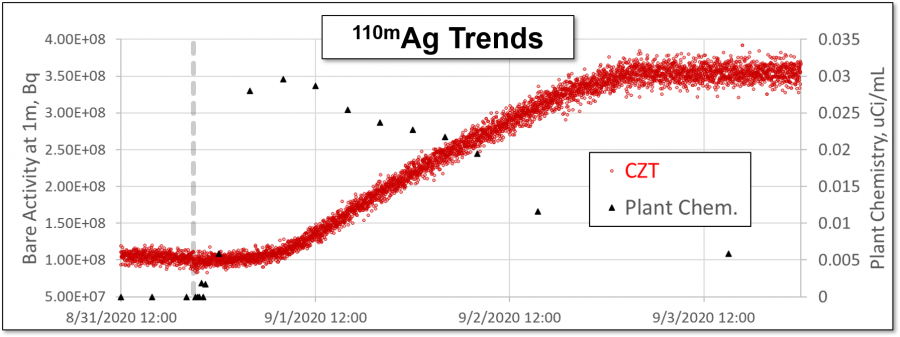Continuous monitoring of reactor coolant in real-time
22nd October 2024

At a glance
> H3D’s GammaTrend system provides continuous monitoring of radiological sources in nuclear power stations, complementing traditional water chemistry and radiation measurements.
> Originally developed in response to a need for better monitoring of CRUD bursts, it can also be used for coolant outage, radiochemistry measurements, and resin bed accumulation.
> Using H3D’s S100 high-resolution CZT gamma spectrometers, GammaTrend can detect radionuclides that collect in pipes, including gamma emitters like 100mAg that can be missed by typical water sampling methods.
Understanding the movement of radioactive materials in PWRs
Originally developed in response to the industry’s need for better monitoring during CRUD bursts in Pressurised Water Reactors, H3D’s GammaTrend monitoring system provides nuclear power stations with real-time data on radiation levels. CRUD consists of corrosive materials, such as metal oxides that accumulate within the reactor coolant system, typically on fuel rods. When a CRUD burst occurs, these particles are suddenly dislodged and begin to circulate within the reactor's coolant, leading to spikes in radiation levels.
GammaTrend helps radiation protection managers understand how power station operations and water chemistry changes can affect the movement of radioactive materials, reducing radiation exposure and shortening maintenance times. Besides CRUD monitoring, it can also be used for coolant outage, radiochemistry measurements, and resin bed accumulation.
High-resolution gamma spectroscopy
Typically including one or more H3D S100 gamma spectrometers, GammaTrend collects and uploads radiation data every minute. The S100 uses Cadmium Zinc Telluride (CZT) detectors for high-resolution gamma spectroscopy. CZT detectors operate at room temperature and do not require cryogenic cooling systems like other high-resolution detectors, making them ideal for extended field use.
GammaTrend’s software allows remote monitoring and control of the detectors so that workers do not need to enter high activity areas. The system can run continuously throughout an operating cycle without needing maintenance, and for higher radiation environments or when there may be interference from other sources, shielded P100S spectrometers can be used instead.

Data collected from the Palisades Nuclear Generating Station in Michigan using the GammaTrend, showing the concentration of 100mAg increasing by almost three times despite water samples showing a decrease. Internal smears of the pipe later confirmed the GammaTrend’s results, demonstrating its effectiveness compared to traditional chemistry samples.
Estimating real-time radionuclide concentration
GammaTrend detects radionuclides that accumulates in pipes, including those that aren't typically captured in water samples like 100mAg. It can even model measurement conditions such as pipe size and materials to estimate real-time radionuclide concentration in the system. For CRUD bursts, GammaTrend’s continuous monitoring allows cleanup progress to be precisely tracked. This real-time data helps detect if cleanup is slower than expected and gives users confidence in predicting when it will end.
It complements traditional water chemistry and radiation measurements, giving operators quick insights to make fast informed decisions, but it also stores and displays long-term data, showing trends in radionuclide levels. This allows users to make considered decisions around improving worker safety and reducing radiation levels.
Find out more
You can learn more about GammaTrend by clicking the button below to speak to a product specialist directly.